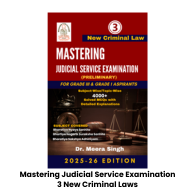

Yoga Theory & Practical
Inhouse product
-
Rs308.00
Rs350.00 -
Rs288.00
Rs300.00 -
Rs238.00
Rs280.00 -
Rs476.00
Rs595.00 -
Rs374.00
Rs425.00 -
Rs175.50
Rs195.00
Reviews & Ratings
"Yoga Theory and Practical" by Dr. Sunita Agarwalla is a comprehensive textbook designed as per the VAC-4 (Value Added Course) syllabus under the FYUGP NEP framework of Dibrugarh University. This book is a compulsory paper for all undergraduate streams—Arts, Science, and Commerce—and aims to instill the principles of holistic well-being, mental clarity, and physical health through the practice and understanding of Yoga.
The book covers both theoretical foundations—such as the philosophy of Yoga, its types, objectives, and benefits—and practical aspects, including asanas, pranayama, and basic meditation techniques. With a simple, student-friendly approach, it serves as an essential guide to improve physical fitness, emotional balance, and overall lifestyle quality. Published by Mahaveer Publications, this book is ideal for both classroom learning and self-practice.
UNIT-01: INTRODUCTION TO YOGA
1.1 Meaning and Definitions of Yoga 1.2 History and Development of Yoga 1.3 Importance of Yoga as Arts, Science and Philosophy
UNIT-02: PHILOSOPHICAL PERSPECTIVE OF YOGA
2.1 Yoga in Bhagavad Gita
- Bhakti Yoga
- Karma Yoga
- Gnana Yoga
- Raja Yoga
2.2 The 'Yoga Sutras' in General: Its Significance in Life 2.3 Limbs/Parts of Yoga (Astanga Yoga) according to the 'Yoga Sutras' 2.4 Concept of Ishwara: Ishwara in Yoga Philosophy
UNIT-03: YOGIC PRACTICES FOR HEALTH & WELLNESS
3.1 Asana, its Classification and Effects 3.2 Pranayama, its Types and Effects 3.3 Kriya, Mudra and Bandha: Procedure and Effects 3.4 Dhyana and its Significance in Human Life
UNIT-04: ALLIED KNOWLEDGE ON YOGA
4.1 Yoga vs Physical Exercise 4.2 Yogic Diet 4.3 Yoga Education Institutes in India and Abroad
PRACTICAL SECTIONS
I. SURYANAMASKARA (Pages 61-136)
II. ASANAS (Pages 63-65)
A. Standing Asanas (Pages 66-116)
- Tadasana
- Ardhakatiachakr asana
- Ardhachakr asana
- Trikon asana
- Utkatasana
- Pada hastasana
- Vrikshasana
B. Sitting Asana
- Vajrasana
- Padmasana
- Bhadrasana
- Siddhasana
- Gomukhasana
- Pascimatatanasana
- Sasankasana
- Ardhamatsyendrasana
- Simhasana
- Ustrasana
C. Lying Supine Position
- Savasana
- Setu bandhasana
- Chakrasana
- Sarvangasana
- Halasana
- Karnapidasana
- Viparit naukasana
- Matsyasana
D. Lying Prone Position
- Makarasana
- Bhujangasana
- Salabhasana
- Dhanurasana
- Naukasana
III. PRANAYAMA (Pages 117-122)
- Nadishodhana
- Suryabhedana
- Chandrabhedana
- Ujjai
- Shitali
- Sikari
- Bhastrika
- Bhramari
IV. BANDH & MUDRA
- Jalandhara bandha
- Uddiyana bandha
- Moola bandha
- Yoga mudra
- Viparitkarmmudra
- Shambhavi mudra
- Yoni mudra
- Mahavedha mudra
V. DHYANA AND ITS FORMS
DETAILED CONTENT
UNIT-01: INTRODUCTION TO YOGA
1.1 Meaning and Definitions of Yoga
Etymology and Root Meaning The word "Yoga" is derived from the Sanskrit root "yuj" which means "to unite," "to join," or "to connect." This fundamental meaning encompasses the essence of yoga as a practice that seeks to unite the individual consciousness (Jivatma) with the universal consciousness (Paramatma).
Classical Definitions:
Patanjali's Definition: "Yogash chitta-vritti-nirodhah" - Yoga is the cessation of fluctuations of the mind. This definition emphasizes the psychological aspect of yoga, focusing on mental discipline and control.
Bhagavad Gita Definitions:
- "Samatvam yoga uchyate" - Yoga is equanimity of mind
- "Yogah karmasu kaushalam" - Yoga is skill in action
- "Dukha-samyoga-viyogam yoga-samjnitam" - Yoga is the disconnection from suffering
Hatha Yoga Pradipika: Defines yoga as the union of the sun (ha) and moon (tha) energies within the body, representing the balance of opposing forces.
Modern Understanding: Yoga is a comprehensive system that integrates physical postures, breathing techniques, meditation, and ethical principles to achieve optimal health, mental clarity, and spiritual growth.
1.2 History and Development of Yoga
Pre-Classical Period (Before 2nd Century BCE)
Indus Valley Civilization (3300-1300 BCE):
- Archaeological evidence of yoga-like practices
- Seal depicting figure in meditation pose (Pashupati seal)
- Early forms of ritualistic practices
Vedic Period (1500-500 BCE):
- First mention of yoga in Rig Veda
- Concept of yoking or controlling the mind
- Vedic sacrificial rituals as early yogic practices
- Development of pranayama (breath control)
Upanishadic Period (800-200 BCE):
- Philosophical foundations established
- Concept of Atman (individual soul) and Brahman (universal soul)
- Meditation techniques developed
- Karma and dharma concepts introduced
Classical Period (2nd Century BCE - 2nd Century CE)
Patanjali's Yoga Sutras (2nd Century BCE):
- Systematic codification of yoga philosophy
- Eight-limbed path (Ashtanga Yoga)
- Definition of yoga and its goals
- Methods for achieving self-realization
Bhagavad Gita (400 BCE - 400 CE):
- Integration of yoga into daily life
- Four main paths of yoga
- Philosophical discourse on duty and spirituality
- Practical application of yogic principles
Post-Classical Period (2nd Century CE onwards)
Tantra and Hatha Yoga (6th-15th Century CE):
- Development of Hatha Yoga Pradipika
- Focus on physical practices
- Introduction of chakras and kundalini
- Body as temple concept
Medieval Period (15th-18th Century):
- Regional variations and schools
- Integration with devotional practices
- Development of various yoga lineages
Modern Period (19th Century-Present):
- Introduction to the West
- Scientific research and validation
- Adaptation for health and wellness
- Global spread and popularization
1.3 Importance of Yoga as Arts, Science and Philosophy
YOGA AS ART
Creative Expression:
- Individual interpretation of postures
- Aesthetic beauty in practice
- Flow and grace in movement
- Personal style development
Artistic Elements:
- Rhythm and timing in practice
- Balance and symmetry
- Breathing as musical accompaniment
- Meditation as creative visualization
Cultural Art Form:
- Traditional teaching methods
- Guru-disciple lineage
- Sanskrit terminology preservation
- Ritualistic aspects
YOGA AS SCIENCE
Systematic Methodology:
- Step-by-step progression
- Measurable outcomes
- Reproducible results
- Evidence-based practices
Scientific Validation:
- Physiological benefits documented
- Psychological improvements measured
- Neurological changes observed
- Biochemical markers studied
Research Areas:
- Stress reduction mechanisms
- Immune system enhancement
- Cardiovascular improvements
- Mental health benefits
- Pain management effectiveness
Anatomical Understanding:
- Musculoskeletal benefits
- Respiratory system improvements
- Nervous system regulation
- Endocrine system balance
YOGA AS PHILOSOPHY
Metaphysical Framework:
- Nature of reality (Sat-Chit-Ananda)
- Individual and universal consciousness
- Cycle of birth and death
- Liberation (Moksha) as ultimate goal
Ethical Guidelines:
- Yamas (moral restraints)
- Niyamas (observances)
- Dharmic living principles
- Social responsibility
Practical Wisdom:
- Life management techniques
- Relationship guidance
- Decision-making framework
- Spiritual growth methodology
UNIT-02: PHILOSOPHICAL PERSPECTIVE OF YOGA
2.1 Yoga in Bhagavad Gita
The Bhagavad Gita presents four main paths of yoga, each suited to different temperaments and inclinations:
BHAKTI YOGA (Path of Devotion)
Definition and Essence: Bhakti Yoga is the path of love and devotion toward the Divine. It emphasizes surrender, faith, and emotional purification through devotional practices.
Core Principles:
- Surrendering ego and personal will
- Developing unconditional love for the Divine
- Seeing divinity in all beings
- Emotional transformation through devotion
Practices:
- Prayer and worship
- Chanting (Kirtan and Bhajan)
- Ritual observances
- Service to others (Seva)
- Reading sacred texts
Nine Forms of Devotion (Nava Vidha Bhakti):
- Shravana (Listening to divine stories)
- Kirtana (Singing divine glories)
- Smarana (Remembering the Divine)
- Pada-sevana (Serving the Divine)
- Archana (Worship and offerings)
- Vandana (Prayer and prostration)
- Dasya (Servant attitude)
- Sakhya (Friendship with Divine)
- Atma-nivedana (Complete surrender)
KARMA YOGA (Path of Action)
Definition and Essence: Karma Yoga is the path of selfless action performed without attachment to results. It transforms ordinary activities into spiritual practice.
Core Principles:
- Action without attachment to fruits
- Duty-bound behavior (Svadharma)
- Service to humanity
- Purification through work
Key Concepts:
- Nishkama Karma (Desireless action)
- Yajna (Sacrificial attitude)
- Lokasangraha (Welfare of the world)
- Samatva (Equanimity in success and failure)
Practical Applications:
- Professional duties as spiritual practice
- Volunteer service
- Family responsibilities
- Social obligations
GNANA YOGA (Path of Knowledge)
Definition and Essence: Gnana Yoga is the path of self-inquiry and wisdom that leads to direct realization of one's true nature.
Core Principles:
- Discrimination between real and unreal
- Self-inquiry and contemplation
- Study of sacred texts
- Direct experience of truth
Four Statements of Truth (Mahavakyas):
- "I am Brahman" (Aham Brahmasmi)
- "Thou art That" (Tat tvam asi)
- "All this is Brahman" (Sarvam khalvidam brahma)
- "Brahman is Consciousness" (Prajnanam brahma)
Practices:
- Self-inquiry (Atma-vichara)
- Study of scriptures (Svadhyaya)
- Contemplation and reflection
- Meditation on the Self
RAJA YOGA (Royal Path)
Definition and Essence: Raja Yoga is the systematic approach to mental discipline and meditation, primarily based on Patanjali's eight-limbed path.
Eight Limbs (Ashtanga):
- Yama (Ethical restraints)
- Niyama (Observances)
- Asana (Physical postures)
- Pranayama (Breath control)
- Pratyahara (Withdrawal of senses)
- Dharana (Concentration)
- Dhyana (Meditation)
- Samadhi (Absorption)
2.2 The 'Yoga Sutras' in General: Its Significance in Life
Structure of Yoga Sutras:
Pada 1: Samadhi (Concentration)
- Definition of yoga
- States of consciousness
- Obstacles and their removal
- Types of concentration
Pada 2: Sadhana (Practice)
- Eight-limbed path
- Ethical guidelines
- Physical and mental practices
- Preparation for higher states
Pada 3: Vibhuti (Supernatural Powers)
- Advanced practices
- Psychic abilities
- Dangers of attachment to powers
- Discrimination and wisdom
Pada 4: Kaivalya (Liberation)
- Ultimate goal of yoga
- Pure consciousness
- Freedom from conditioning
- Establishment in true nature
Practical Life Applications:
Stress Management:
- Breath awareness techniques
- Mental concentration practices
- Ethical living principles
- Regular meditation routine
Relationship Enhancement:
- Ahimsa (Non-violence) in interactions
- Satya (Truthfulness) in communication
- Santosha (Contentment) in expectations
- Compassion and understanding
Professional Development:
- Focused attention (Dharana)
- Clarity of thought
- Ethical decision-making
- Leadership qualities
2.3 Limbs/Parts of Yoga (Astanga Yoga) according to the 'Yoga Sutras'
THE EIGHT LIMBS OF YOGA
1. YAMA (Ethical Restraints)
Ahimsa (Non-violence):
- Physical: Avoiding harm to all beings
- Mental: Controlling anger and hatred
- Verbal: Speaking kindly and truthfully
- Environmental: Sustainable living practices
Satya (Truthfulness):
- Honest communication
- Authentic living
- Alignment of thoughts, words, and actions
- Speaking helpful truth
Asteya (Non-stealing):
- Not taking what doesn't belong to us
- Time management and punctuality
- Gratitude and contentment
- Respecting others' resources
Brahmacharya (Energy management):
- Traditional: Celibacy for spiritual aspirants
- Modern: Conscious use of sexual energy
- Moderation in all activities
- Conservation of vital energy
Aparigraha (Non-possessiveness):
- Freedom from greed
- Living simply
- Sharing resources
- Non-attachment to material things
2. NIYAMA (Observances)
Saucha (Cleanliness):
- Physical hygiene and purity
- Mental clarity and positive thoughts
- Environmental cleanliness
- Purification practices
Santosha (Contentment):
- Satisfaction with what one has
- Inner peace and happiness
- Gratitude practice
- Acceptance of circumstances
Tapas (Disciplined practice):
- Sustained effort and dedication
- Self-discipline and willpower
- Austerity and simplicity
- Commitment to practice
Svadhyaya (Self-study):
- Study of sacred texts
- Self-reflection and introspection
- Understanding one's nature
- Continuous learning
Ishvara Pranidhana (Surrender to Divine):
- Devotion and surrender
- Recognition of higher power
- Humility and faith
- Service and dedication
3. ASANA (Physical Postures)
- Steady and comfortable postures
- Physical strength and flexibility
- Preparation for meditation
- Health and vitality
4. PRANAYAMA (Breath Control)
- Regulation of life force
- Extension of breath and life
- Purification of energy channels
- Mental calm and clarity
5. PRATYAHARA (Withdrawal of Senses)
- Turning attention inward
- Control over sensory distractions
- Mental discipline
- Preparation for concentration
6. DHARANA (Concentration)
- Single-pointed focus
- Mental steadiness
- Sustained attention
- Object-based meditation
7. DHYANA (Meditation)
- Effortless awareness
- Uninterrupted flow of consciousness
- Deep absorption
- Transcendence of duality
8. SAMADHI (Absorption)
- Complete union with object of meditation
- Loss of separate self-sense
- Pure consciousness
- Ultimate goal of yoga
2.4 Concept of Ishwara: Ishwara in Yoga Philosophy
Definition of Ishwara: Ishwara, in Yoga philosophy, represents the supreme consciousness or God - a special kind of soul (Purusha) that is eternally free from afflictions, actions, and their results.
Characteristics of Ishwara:
- Untouched by suffering and karma
- Omniscient and omnipresent
- Source of all knowledge
- Supreme teacher and guide
Role in Yoga Practice:
- Object of devotion and surrender
- Source of inspiration and guidance
- Facilitator of spiritual progress
- Ultimate refuge in difficulties
Practical Applications:
- Ishvara Pranidhana as practice
- Prayer and worship
- Surrender of ego and results
- Trust in divine timing
UNIT-03: YOGIC PRACTICES FOR HEALTH & WELLNESS
3.1 Asana, its Classification and Effects
DEFINITION AND PURPOSE OF ASANAS
Classical Definition: "Sthira sukham asanam" - Asana should be steady and comfortable. This fundamental principle from Patanjali emphasizes the balance between effort and ease in physical practice.
Modern Understanding: Asanas are specific body postures designed to cultivate physical strength, flexibility, balance, and mental calm while preparing the body for meditation.
CLASSIFICATION OF ASANAS
A. STANDING ASANAS
Benefits of Standing Poses:
- Strengthen legs and core
- Improve balance and stability
- Enhance circulation
- Build confidence and grounding
Key Standing Asanas:
1. TADASANA (Mountain Pose)
- Technique: Stand with feet together, arms at sides, crown reaching up
- Benefits: Improves posture, strengthens legs, enhances awareness
- Duration: 30 seconds to 2 minutes
- Variations: Arms overhead, heel raises
2. VRIKSHASANA (Tree Pose)
- Technique: Balance on one leg, other foot on inner thigh
- Benefits: Improves balance, strengthens legs, enhances concentration
- Modifications: Use wall support, foot on calf
- Contraindications: Recent knee or ankle injuries
3. TRIKONASANA (Triangle Pose)
- Technique: Wide-legged forward fold with side bend
- Benefits: Stretches spine, strengthens legs, improves digestion
- Alignment: Keep front leg straight, hand on shin or block
- Modifications: Use block under bottom hand
B. SITTING ASANAS
Benefits of Seated Poses:
- Promote introspection and calm
- Strengthen spine and core
- Improve hip flexibility
- Prepare for pranayama and meditation
Key Sitting Asanas:
1. SUKHASANA (Easy Pose)
- Technique: Cross-legged sitting with erect spine
- Benefits: Calms mind, improves posture, enhances flexibility
- Props: Cushion or blanket under hips
- Duration: 5-20 minutes
2. PADMASANA (Lotus Pose)
- Technique: Full lotus with feet on opposite thighs
- Benefits: Ultimate meditation pose, enhances concentration
- Preparation: Hip opening poses, gradual progression
- Precautions: Avoid forcing the position
3. VAJRASANA (Diamond Pose)
- Technique: Kneeling position, sitting on heels
- Benefits: Aids digestion, strengthens legs, calms mind
- Timing: Can be practiced after meals
- Duration: 5-15 minutes
C. LYING SUPINE POSITIONS
Benefits of Supine Poses:
- Deep relaxation and restoration
- Spinal alignment and decompression
- Stress relief and mental calm
- Gentle backbends and inversions
Key Supine Asanas:
1. SAVASANA (Corpse Pose)
- Technique: Lie flat with arms and legs slightly apart
- Benefits: Complete relaxation, stress relief, integration
- Duration: 10-20 minutes
- Guidance: Systematic body awareness, breath observation
2. SETU BANDHASANA (Bridge Pose)
- Technique: Lift hips from supine position
- Benefits: Strengthens back, opens chest, energizes body
- Modifications: Block between thighs, shoulder stand preparation
- Progression: Wheel pose preparation
D. LYING PRONE POSITIONS
Benefits of Prone Poses:
- Strengthen back muscles
- Open chest and shoulders
- Stimulate digestive organs
- Build confidence and courage
Key Prone Asanas:
1. BHUJANGASANA (Cobra Pose)
- Technique: Lift chest using back muscles, minimal hand pressure
- Benefits: Strengthens spine, opens heart, improves posture
- Variations: Low cobra, high cobra, dynamic movement
- Precautions: Avoid excessive neck extension
2. SALABHASANA (Locust Pose)
- Technique: Lift legs and chest simultaneously
- Benefits: Strengthens entire back body, improves posture
- Variations: Single leg, arms forward, dynamic
- Preparation: Gentle back bends, core strengthening
3.2 Pranayama, its Types and Effects
DEFINITION AND SIGNIFICANCE
Classical Understanding: "Prana" means life force or vital energy, and "Yama" means restraint or extension. Pranayama is the conscious regulation of breath to control and expand life force.
Components of Breath:
- Puraka: Inhalation
- Rechaka: Exhalation
- Kumbhaka: Retention (internal and external)
TYPES OF PRANAYAMA
1. NADISHODHANA (Alternate Nostril Breathing)
- Technique: Use thumb and ring finger to alternately close nostrils
- Benefits: Balances nervous system, improves concentration
- Ratio: Start with equal timing, progress to 1:1:1
- Duration: 5-15 minutes
2. UJJAYI (Victorious Breath)
- Technique: Slight throat constriction creating oceanic sound
- Benefits: Calms mind, generates internal heat, improves focus
- Application: During asana practice and meditation
- Sound: Soft, steady, audible breathing
3. BHASTRIKA (Bellows Breath)
- Technique: Forceful inhalation and exhalation
- Benefits: Energizes body, clears mind, improves circulation
- Precautions: Practice on empty stomach, avoid if pregnant
- Rounds: 10 breaths per round, 3-5 rounds
4. SHITALI (Cooling Breath)
- Technique: Inhale through curled tongue, exhale through nose
- Benefits: Cools body, reduces stress, calms mind
- Season: Particularly beneficial in summer
- Duration: 5-10 minutes
EFFECTS OF PRANAYAMA
Physical Effects:
- Improved respiratory function
- Enhanced cardiovascular health
- Better oxygen circulation
- Strengthened immune system
- Balanced nervous system
Mental Effects:
- Increased concentration
- Reduced stress and anxiety
- Enhanced emotional stability
- Improved mental clarity
- Better sleep quality
Spiritual Effects:
- Awakened awareness
- Deeper meditation states
- Increased life force
- Expanded consciousness
- Greater inner peace
3.3 Kriya, Mudra and Bandha: Procedure and Effects
KRIYAS (Cleansing Practices)
Purpose and Benefits: Kriyas are purification techniques that cleanse the body and prepare it for higher yogic practices.
Major Kriyas:
1. NETI (Nasal Cleansing)
- Jala Neti: Salt water cleansing
- Sutra Neti: Thread cleansing
- Benefits: Clear sinuses, improve breathing, prevent infections
- Frequency: Daily during allergy season, weekly otherwise
2. DHAUTI (Digestive Cleansing)
- Techniques: Various methods for cleansing digestive tract
- Benefits: Improved digestion, reduced acidity, mental clarity
- Types: Cloth swallowing, water cleansing, air cleansing
MUDRAS (Symbolic Hand Gestures)
Definition and Purpose: Mudras are symbolic hand positions that channel energy and enhance concentration during meditation and pranayama.
Key Mudras:
1. GYAN MUDRA
- Position: Thumb and index finger touching, other fingers extended
- Benefits: Enhances concentration, improves memory
- Use: During meditation and pranayama
- Symbolism: Union of individual and cosmic consciousness
2. SHAMBHAVI MUDRA
- Technique: Gazing at the point between eyebrows
- Benefits: Improves concentration, awakens intuition
- Duration: Start with 1-2 minutes, gradually increase
- Precautions: Avoid strain, practice gently
BANDHAS (Energy Locks)
Purpose and Function: Bandhas are internal muscular contractions that redirect and control the flow of prana (life force) in the body.
Three Main Bandhas:
1. MULA BANDHA (Root Lock)
- Location: Pelvic floor muscles
- Technique: Gentle contraction and lifting of perineum
- Benefits: Core strength, energy conservation, spinal support
- Application: During asanas, pranayama, and meditation
2. UDDIYANA BANDHA (Upward Flying Lock)
- Location: Lower abdomen
- Technique: Pull navel up and in on empty breath retention
- Benefits: Strengthens core, improves digestion, energizes
- Timing: Only on empty stomach, morning practice
3. JALANDHARA BANDHA (Throat Lock)
- Location: Throat and neck region
- Technique: Lower chin toward chest during breath retention
- Benefits: Stimulates thyroid, conserves energy, calms mind
- Application: During pranayama practice
3.4 Dhyana and its Significance in Human Life
DEFINITION AND ESSENCE
Classical Definition: Dhyana is sustained, effortless awareness - the seventh limb of Patanjali's eight-fold path, characterized by uninterrupted flow of consciousness toward the object of meditation.
Distinction from Concentration:
- Dharana: Focused attention with effort
- Dhyana: Effortless, sustained awareness
- Samadhi: Complete absorption, loss of separate self
TYPES OF MEDITATION
1. Breath Awareness Meditation
- Focus on natural breath rhythm
- Observe inhalation and exhalation
- Develop steady attention
- Gateway to deeper states
2. Mantra Meditation
- Repetition of sacred sounds
- Examples: Om, So Hum, Gayatri Mantra
- Vibrational effects on consciousness
- Traditional and personal mantras
3. Mindfulness Meditation
- Present moment awareness
- Observation without judgment
- Body sensations, thoughts, emotions
- Integration into daily activities
4. Visualization Meditation
- Mental imagery and symbols
- Deity meditation in traditions
- Light and energy visualization
- Chakra meditation
SIGNIFICANCE IN HUMAN LIFE
Mental Health Benefits:
- Reduced stress, anxiety, and depression
- Improved emotional regulation
- Enhanced cognitive function
- Better sleep and relaxation
- Increased self-awareness
Physical Health Benefits:
- Lower blood pressure
- Improved immune function
- Reduced inflammation
- Better pain management
- Enhanced healing processes
Spiritual Development:
- Expanded consciousness
- Greater inner peace
- Deeper self-understanding
- Connection with higher purpose
- Transcendence of limiting beliefs
Social Benefits:
- Improved relationships
- Greater empathy and compassion
- Better communication skills
- Reduced reactivity
- Enhanced leadership qualities
UNIT-04: ALLIED KNOWLEDGE ON YOGA
4.1 Yoga vs Physical Exercise
FUNDAMENTAL DIFFERENCES
Philosophy and Approach:
Yoga:
- Holistic system integrating body, mind, and spirit
- Emphasis on inner awareness and consciousness
- Non-competitive, self-reflective practice
- Unity and connection as primary goals
- Process-oriented rather than result-oriented
Physical Exercise:
- Primarily focused on physical fitness and performance
- External achievement and measurable results
- Often competitive and goal-driven
- Muscle building and cardiovascular health
- Result-oriented with specific targets
METHOD AND TECHNIQUE
Yoga Practice:
- Slow, mindful movements with breath awareness
- Holding poses for extended periods
- Integration of breathing techniques
- Meditation and relaxation components
- Respect for body's limitations
Physical Exercise:
- Repetitive movements for muscle conditioning
- High intensity and rapid movements
- Focus on calorie burning and strength building
- Limited attention to breathing patterns
- Push through discomfort mentality
BENEFITS COMPARISON
Shared Benefits:
- Improved physical strength and flexibility
- Better cardiovascular health
- Stress reduction and mood enhancement
- Increased energy and vitality
- Better sleep patterns
Unique Yoga Benefits:
- Enhanced self-awareness and mindfulness
- Emotional regulation and mental clarity
- Spiritual growth and inner peace
- Improved concentration and focus
- Better stress management skills
- Hormonal balance and nervous system regulation
Unique Exercise Benefits:
- Rapid muscle mass development
- High calorie burning for weight loss
- Sport-specific skill development
- Competitive achievement satisfaction
- High-intensity cardiovascular conditioning
4.2 Yogic Diet
PRINCIPLES OF YOGIC NUTRITION
Three Gunas in Food:
Sattvic Foods (Pure, Harmonious):
- Characteristics: Fresh, natural, wholesome
- Examples: Fresh fruits, vegetables, whole grains, nuts, seeds, dairy
- Effects: Clarity of mind, peaceful disposition, spiritual growth
- Preparation: Minimal processing, cooked with love and awareness
Rajasic Foods (Stimulating, Active):
- Characteristics: Spicy, salty, sour, stimulating
- Examples: Onions, garlic, coffee, tea, spices, processed foods
- Effects: Restlessness, agitation, excessive activity
- Moderation: Limited consumption for balanced energy
Tamasic Foods (Dull, Inert):
- Characteristics: Stale, processed, heavy, intoxicating
- Examples: Meat, alcohol, drugs, stale food, overly processed items
- Effects: Lethargy, confusion, depression, spiritual darkness
- Avoidance: Minimized or eliminated from yogic diet
YOGIC EATING PRACTICES
Mindful Eating:
- Eat in peaceful, clean environment
- Express gratitude before meals
- Chew food thoroughly and slowly
- Pay attention to taste, texture, and satisfaction
- Avoid distractions during eating
Proper Timing:
- Eat when genuinely hungry
- Allow 3-4 hours between meals
- Light dinner 2-3 hours before sleep
- Morning practice on empty stomach
- Seasonal eating aligned with nature
Quantity Guidelines:
- Fill stomach 1/2 with food, 1/4 with water, 1/4 empty
- Avoid overeating and under-eating
- Listen to body's hunger and satiety signals
- Quality over quantity emphasis
Food Combinations:
- Avoid incompatible food combinations
- Fruit eaten separately from meals
- Proper protein and carbohydrate pairing
- Seasonal and local food preference
4.3 Yoga Education Institutes in India and Abroad
PREMIER INSTITUTIONS IN INDIA
1. Kaivalyadhama Health and Yoga Research Center, Lonavla
- Founded: 1924 by Swami Kuvalayananda
- Specializations: Scientific research, therapeutic yoga, teacher training
- Programs: Certificate, diploma, and degree courses
- Research: Pioneering scientific studies on yoga
Frequently Bought Products
English Language & Communication Skills
Product Queries (0)
Login Or Registerto submit your questions to seller
Other Questions
No none asked to seller yet
-
Rs308.00
Rs350.00 -
Rs288.00
Rs300.00 -
Rs238.00
Rs280.00 -
Rs476.00
Rs595.00 -
Rs374.00
Rs425.00 -
Rs175.50
Rs195.00
Mahaveer Publications
Mahaveer Publications is a trusted name in the world of printing and publishing, renowned for delivering high-quality printed materials tailored to meet the needs of individuals, businesses, and organizations. Specializing in books, brochures, magazines, and custom printing solutions, Mahaveer Publications combines state-of-the-art technology with a commitment to excellence. With a focus on precision, creativity, and timely delivery, the company has earned the trust of clients seeking professional and impactful print solutions.
Dedicated to fostering knowledge and communication, Mahaveer Publications is more than just a printing service—it's a partner in bringing ideas to life. From concept to completion, the team ensures that every project reflects the client's vision while maintaining the highest standards of craftsmanship. With a passion for innovation and a customer-centric approach, Mahaveer Publications continues to set benchmarks in the printing and publishing industry.








